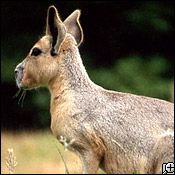The Patagonian cavy, also called the Patagonian hare, has long legs similar to those of rabbits and hares.
In areas without lagomorphs, it may fill the same niche; where the European hare has been introduced, its numbers are in decline.
Advertisement
When chased, the Patagonian cavy can gallop at fifty miles (80 km) per hour, making leaps of six feet (2 m).
Groups of as many as forty may come together to feed on grasses, acacia seeds, and sometimes cactus.
Within these groups, pairs and occasionally trios bond, staying together year-round.
The young of twenty or so pairs stay in communal burrows; the mothers visit the burrows regularly, whistling to the young to come out and nurse.
Advertisement
